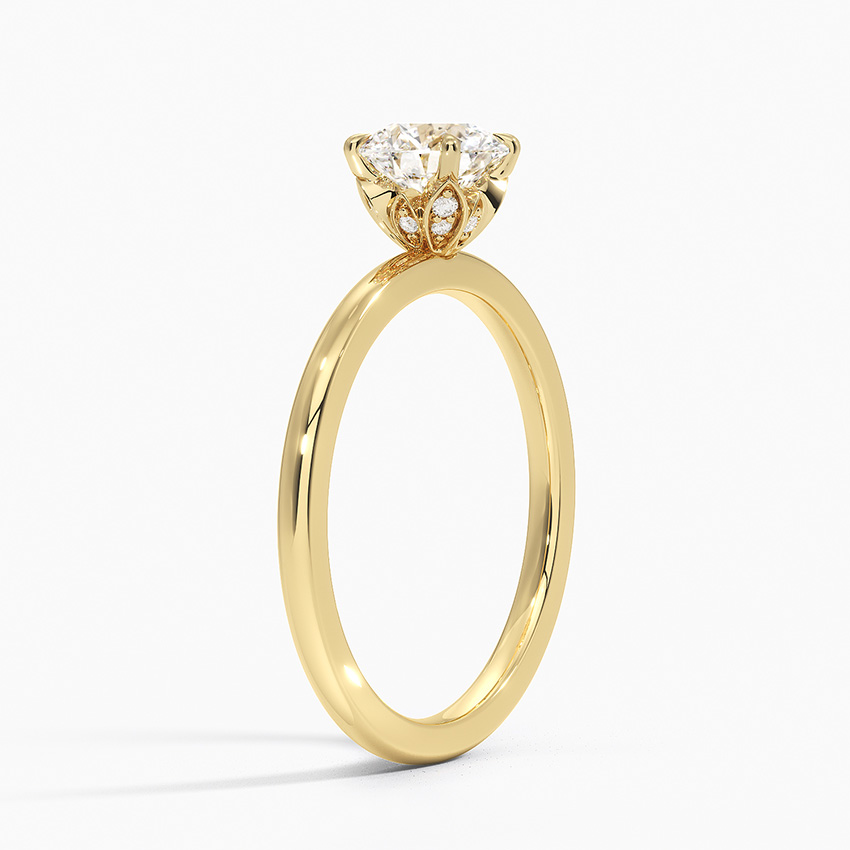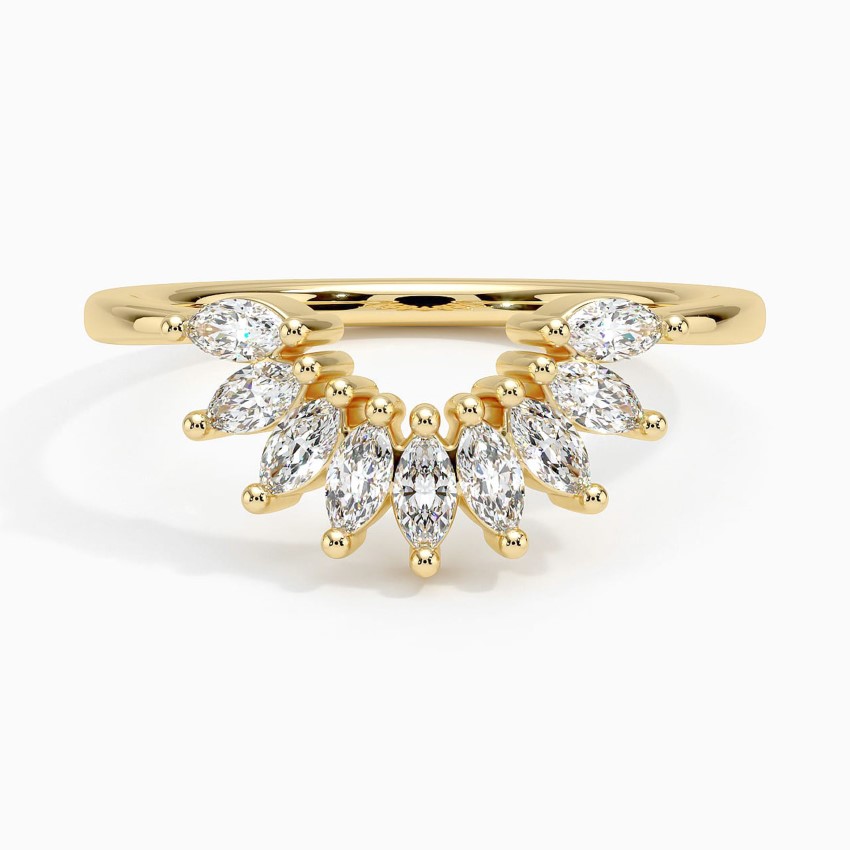
With a flower engagement ring, you can present your partner with flowers every day. Pick their favorite florals, choose one for its meaning, or incorporate their preferred color gemstone. There are a variety of ways to flaunt a floral look, depending on the details you choose to accentuate the pattern. You decide how subtle or realistic you want your flower engagement ring to be.
What are flower engagement rings?
A flower engagement ring falls into the category of nature-inspired rings — ones with purely botanical motifs. For example, milgrain might emphasize the veining of leaves; a cluster arrangement can resemble a bouquet; a wispy scroll of metal vines can give a garland effect to your gems. From flower carvings to a hidden halo of petals, here are the most common ways a flower engagement ring can blossom.
1) Flower engagement ring setting: These settings feature floral accents along the band, gallery, and prongs of a ring – or on all three. Classic examples include milgrain detailing that sweeps upwards like a vine, marquise diamond accents that look like buds, and subtly floral engravings that add a hint of botanical bloom to designs.
2) Floral center stone: Rounded or elongated shapes are best for mimicking the center of a flower. Think oval or pear forms, and marquise or cushion cuts. You can also use these fancy diamond shapes to design artistic leaves and boughs around your center stone. Or beneath it, with a rounded gem that sits high like a bud on top of claw prongs.
3) A halo setting: If you want the top-down illusion of looking onto a flower, design the halo around your center stone to look like petals. This is commonly achieved with an arrangement of outer pavé gems. For a minimal aesthetic, you can opt for all metal shapes where petal placement and the prongs holding them work together to create the body of a flower.
Flower Meanings for Engagement Rings
When you’ve found a gorgeous floral design you know your partner will love (or if you’d rather start with their favorite flower), you can explore the floral language of love. Each flower has its own meaning. When suitors and secret admirers in the Victorian era wanted to make their feelings (inconspicuously) known, they’d send the flowers that represented their emotions. Here are a few common themes:
- Lily: purity, rebirth
- Ivy: fidelity
- Forget-me-not: true love, remembrance
- Sunflower: good luck, adoration, longevity, positivity
- Daisy: innocence, hope, new beginnings, joy
- Tulip: declaration of love
- Rose: passion, respect
- Violet: loyalty, devotion, faith
- Lotus: enlightenment
- Orchid: strength, grace
Any flower can be a thoughtful reflection of your relationship, your partner, or your intentions. You can also choose your partner’s birth flower (just like gemstones, each month is assigned a flower).
Popular Gemstones for Flower Engagement Rings
A floral engagement ring often combines rich or pastel hues for the center stone and its setting. Here are the most common gemstones that display the beauty of Mother Nature. Just like flowers, each gem has its own meaning.
Diamond
As the ultimate symbol of commitment and eternity, it shares the sentiment of the rose. White or colored diamonds are popular for center stones and decorative accents in any flower. They inspire enduring love because of their toughness. They’re also attached to purity, fitting for their brilliance and clarity.
Sapphire
Known for deep blue hue, sapphires actually come in most colors. High on the Mohs scale of hardness, they’re long-lasting and scratch resistant. These gems state wisdom and nobility, a good match for a lily.
Ruby
Fiery red, these richly colored gems are all about desire. While suited for a rose, a ruby can add energy to any vibrant floral.
Emerald
The lush green shade is ideal for literal interpretations of plant life, including accent stones that stand in for leaves and stems. Emeralds signify growth, so they’re perfect for an engagement ring before starting the next chapter. As natural emeralds are softer than the other gems, you’ll want a secure setting, like a bezel.
Our Favorite Flower Engagement Rings
Whether you want the precision of a piece that mimics the geometry found in nature or something truly botanical, a floral design is always in style. Here is our roundup of nature engagement rings inspired by the wonders of the wild.
Secret Garden Diamond Engagement Ring
Glistening marquise-shaped diamond buds rest on whimsical vines of precious metal winding towards the center gem for a look of natural elegance
Camellia Indigo Milgrain Engagement Ring
 A milgrain filament winds upwards towards aquamarines, diamonds, and lab alexandrties that rest at either side of the center stone for a subtly floral look, while a trellis-style head adds a bit of blue-hued whimsy.
A milgrain filament winds upwards towards aquamarines, diamonds, and lab alexandrties that rest at either side of the center stone for a subtly floral look, while a trellis-style head adds a bit of blue-hued whimsy.
Petal Diamond Engagement Ring
Willow Engagement Ring with Lab Emerald Accents
A beautiful center gem blooms from within shimmering diamond leaves in this chic and memorable setting.
Sweeping Ivy Diamond Engagement Ring
This feminine, nature-inspired ring showcases a dazzling center gem blooming from within a gallery of shimmering diamond petals.
Nadia Halo Diamond Engagement Ring
A lavish take on classic, this setting features a dazzling halo of diamonds that wraps the glistening center stone in an aura of light.
Winding Ivy Diamond Engagement Ring
Rosita Halo Diamond Engagement Ring
Celebrity Flower Engagement Rings
- Katy Perry: Her pinkish-orange oval-cut ruby is set in a cluster of eight white diamonds to form the petals of a flower. The opulent band is also adorned with smaller diamonds.
- Nikki Reed: An enormous, instant classic and go-to floral design. Her 4ct round white diamond has a halo of bezel set round diamonds.
- Miranda Kerr: The former Victoria’s Secret Angel has an exquisite three-stone diamond arrangement showcasing a round brilliant center stone accompanied by petals of tapered baguette side stones.
- Natalie Portman: All-out diamonds. The Oscar-winning actress has an antique-inspired flower ring. An oval-cut center diamond has an intricate diamond halo and sits above a mesmerizing V-shaped display of pavé-set gems. The band is also encrusted with diamonds.
- Jamie Lynn Spears: The younger sister of Britney Spears received a timeless flower-shaped engagement ring. A rounded center stone sits on a simple, elegant band.
- Ashley Tisdale: The High School Musical star got engaged with a 2ct cushion-cut diamond taking center stage. It’s surrounded by a dazzling double halo setting, and all of it’s nestled on a platinum band adorned with glistening diamonds.
- Jenna Dewan: The actress and dancer received a 2.5ct flower-inspired engagement ring in a yellow gold pavé halo setting.
Flower Wedding Rings to Complete Your Bridal Set
Don’t worry if you don’t want to commit to the sculptural silhouette of a flower engagement ring or if you weren’t able to get one. It’s not too late. You can turn your ring into a flower with your wedding band. Flower wedding rings have all the same charm. Whether it’s a yellow gold or a rose gold, you can enhance or achieve a natural look with a wedding band.
- Matching: For a cohesive look, finish your wedding band with the same metals as your engagement ring. Or match similar details; find a wedding ring that also has dainty, gentle filigree, or is equally architectural. You might work in the exact gem, but in a different color.
- Nature inspired: If your wedding band is the only nature-inspired ring you wear, cast the metal to echo the shape of a flower. Attaching or engraving your floral elements along the wedding ring band adds texture. It’s also less obvious, if your partner would enjoy an understated motif.
Why Choose a Flower Engagement Ring
With more gems and more intricacy involved in the gems’ placement, flower engagement rings are natural beauties. They’re fresh, unique, inexpensive options if you’re looking for jewelry with a big presence and stunning sparkle. Elegant or whimsical, flower engagement rings symbolize growth, offering rich colors to brighten your partner’s day. There are endless options to express your creativity.























